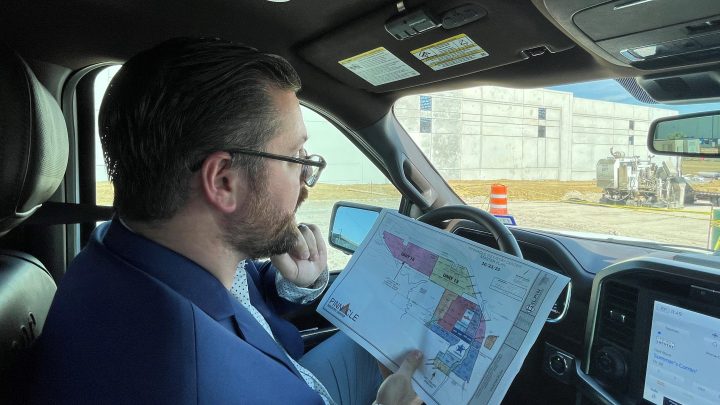
With Mexico as top U.S. trade partner, industrial real estate booms in Laredo
With Mexico as top U.S. trade partner, industrial real estate booms in Laredo

With up to 20,000 trucks filled with auto parts, avocados and other goods passing through the Port of Laredo daily, warehouses play a key role in storing these goods before they’re shipped to manufacturing plants and distribution centers in cities like Toronto, Dallas or Monterrey, Mexico.
The growth in U.S.-Mexico trade at the Port of Laredo, now the No. 1 port in the country, has sparked major growth in local industrial real estate — a market that has remained extremely tight, according to Adrian Ponsen, an analyst at real estate data firm CoStar.
“Laredo is really in a situation where retailers and logistics companies are gobbling up space about as fast as developers can build it there,” Ponsen said.
Available storage space has dwindled at the Nippon Express warehouse, run by a Japanese logistics company in Laredo, Texas. Towering orange racks were recently added to the 100,000-square-foot space, allowing pallets of car parts — like oil filters and Tesla seat fabric — to be stacked high up in the warehouse, making room for more goods, according to Trey Hughes, operations manager at the warehouse.
“We can’t handle the business we have with this space,” he said, “And I’m sure a lot of companies are that way.”

That’s why Nippon Express is breaking ground on two new Laredo warehouses in the coming months.
It’s just one of several companies expanding its industrial footprint in Laredo as supply chains become more regional and trade with Mexico grows — the country recently surpassed China as the United States’ top trading partner.
The port city on the Rio Grande has benefitted from the reordering of global supply chains spurred by Chinese tariffs, the new North American trade agreement, pandemic-related disruptions and recent U.S. industrial policy intended to spur regional manufacturing.
While Laredo’s once marginal market for industrial storage has expanded since the North American Free Trade Agreement was signed in 1992, recent growth in trade coming through Laredo is ushering in a new era of opportunity, according to Rolando Ortiz, chief operating officer for real estate firm Killam Development, a firm he’s worked at for almost 30 years.
“There’s going to be a dramatic amount of industrial space being built in this community,” he said. “And it’s all spurred from this nearshoring concept and supply chain reliability.”
In Laredo, local stock of industrial properties has grown roughly 20% in the past five years, according to Ponsen with CoStar.
“That’s double the growth rate for industrial space in the U.S. as a whole,” he said.

The market for industrial real estate has cooled nationally, but Laredo is defying that trend, Ponsen said. The city has less than 3% of industrial real estate space available, compared to 4% to 8% in other major markets in the country.
“Laredo is definitely bucking the slowdown in the industrial market that’s happening in the rest of the U.S.,” he said, attributing that to its strategic location at the border with Mexico, which has attracted more manufacturing to serve the U.S. market.
Ponsen said CoStar listed a single available industrial property available to lease in Laredo that is larger than 200,000 square feet, located inside Pinnacle Industry Center, one of several industrial parks that have sprung up in Laredo in recent years.
Pinnacle Industry Center CEO AJ Kraus said he doesn’t expect it to take long to lease the property, and more developments are on the horizon.
He and his father began buying up ranch land to develop the industrial park in 2016 and have kept at it.
“We saw that these larger lots were going to be needed, so we built these lots and they sold like hotcakes,” he said.
Kraus remembered when 100,000-square-foot buildings used to make head turns in Laredo.
“That’s small stuff. Now you’re looking at buildings easily 200, 300, 400, even 500,000 to 600,000 square feet,” he said.
He called the industrial park off of Mines Road in Laredo “valley of the giants” because of the enormous warehouses that dominate the landscape.

Developers across the border in Nuevo Laredo, Mexico, have also been eager to make space for the growing amount of goods passing through the region.
While business has been steady for industrial real estate developer Guillermo Fernandez de Jauregui since the 1990s, he said the biggest growth has been in the last two years.
“After COVID, we have ramped up a lot,” he said. Before the pandemic, they had three facilities — a number that will soon triple.
“We going to build our ninth distribution center because of the needs of improving the supply chain and moving the supplies over here,” he said.
There’s a lot happening in the world. Through it all, Marketplace is here for you.
You rely on Marketplace to break down the world’s events and tell you how it affects you in a fact-based, approachable way. We rely on your financial support to keep making that possible.
Your donation today powers the independent journalism that you rely on. For just $5/month, you can help sustain Marketplace so we can keep reporting on the things that matter to you.











